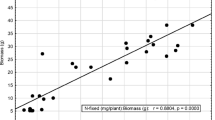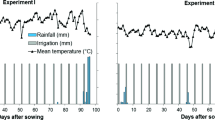Abstract
Few studies have assessed the levels of symbiotic N nutrition in legumes grown by farmers in Africa. In this study, the shoots of cowpea plants were sampled from 63 farms in 12 villages within 5 districts of the Upper West Region of Ghana, and assessed for growth and symbiotic N nutrition. The data revealed considerable differences in cowpea plant density per m2, plant growth,15N natural abundance (δ15N), %Ndfa, and N-fixed among different farms under one village, and between villages under the same district, and between districts in the Upper West Region. In farms where there were fewer cowpea plants per m2, plant growth was better and dry matter yield per plant significantly greater, leading to strong variations in δ15N values. Except for four farms at Bamahu which had cowpea shoot Ndfa values of 12.1%, 30.0%, 36.5% and 46.6%, one farm at Babile with Ndfa value of 58.1%, and three farms at Silbelle with Ndfa values of 56.8%, 57.9% and 68.7%, the remaining 55 out of the 63 farms studied showed high shoot Ndfa values, ranging from 70.6% to 99.7%, which clearly indicates that cowpea cultivated by farmers in the Upper West Region of Ghana meet a large proportion of their N requirements from symbiotic fixation. At the district level, isotopic analysis showed that, on average, the15N natural abundance values (%0) of cowpea shoots were −0.496±0.04 for Jirapa, −0.083±0.06 for Nadowli, 0.368±0.08 for Lawra, J.333±0.29 for Wa and 0.365±0.09 for Sissala district. Estimates of the legume’s N derived from fixation were 66.3% for Wa district, 89.9% for Nadowli, 79.4% for Lawra, 78.9% for Sissala and 80.9% for Jirapa district. The amount of N-fixed ranged from 402.3 mg.plant−1 for Nadowli, 176.5 mg.plant−1 for Wa, 235.4 mg.plant−1 for Sissala, 179.0 mg.plant−1 for Lawra to 249.2 mg.plane−1 for the Jirapa district. Expressed on per-hectare basis using cowpea density per m2, the total amount of N-fixed was around 16.6 kg ha−1 in the Nadowli district, 19.1 kg ha−1 in Wa, 23.0 kg ha−1 in Sissala, 2J.1 kg ha−1 in Lawra and 17.6 kg ha−1 in the Jirapa district. Averaged across all 5 districts, N-fixed by cowpea was about 19.5 kg ha−1 in the Upper West Region of Ghana. These data suggest that, increasing N2 fixation in fanners’ fields in Ghana would require optimization of cowpea plant density rather than biological manipulation of the symbiotic process (as %Ndfa values were generally very high).
Similar content being viewed by others
References
Adjei-Nsiah, S., Kuyper, T.W., Leeuwis, C., Abekoe, M.K., Cobbinah, J., Sakyi-Dawson, O., and Giller, K.E., 2008. Farmers’ agronomic and social evaluation of productivity, yield and N2-fixation in different cowpea varieties and their subsequent residual N effects on succeeding maize crop.Nutrient Cycling in Agroecosystems 80: 199–209.
Adu-Gyamfi, J.J., Mayaka, F.A., Sakala, W.D., Odgaard, R., Versterager, J.M., and Hogh-Jensen, H. 2007. Biological nitrogen fixation and nitrogen and phosphorus budgets in farmer-managed intercrops of maize-pigeon pea in semi-arid Southern and Eastern Africa.Plant and Soil 295: 127–136.
Anderson, J.M. and Ingram, J.S.I., eds. 1993.Tropical Soil Biology and Fertility. A Handbook of Methods. CAB International. 2nd ed. pp. 36–43, 57–73, and 93–97.
Awonaike, K.O., Kumarasinghe, K.S., and Danso, S.K.A. 1990. Nitrogen fixation and yield of cowpea (Vigna unguiculata) as influenced by cultivar andBradyrhizobium strain.Field Crops Research 24: 163–171.
Ayisi, K.K., Nkgapele, R.J., and Dakora, F.D. 2000. Nodule formation and function in six varieties of cowpea (Vigna unguiculata L. Walp) grown in a nitrogen-rich field soil in South Africa.Symbiosis 28: 17–31.
Bado, B.V., Bationo, A., and Cescas, M.P. 2006. Assessment of cowpea and groundnut contributions to soil fertility and succeeding sorghum yields in the Guinean savannah zone of Burkina Faso (West Africa).Biology and Fertility of Soils 43: 171–176.
Bagayoko, M., Buerkert, A., Lung, G., Bationo, A., and Römheld, V. 2000. Cereal/legume rotation effects on cereal growth in Sudano-Sahelian West Afrrica: Soil mineral nitrogen, mycorrhizae and nematodes.Plant and Soil 218: 103–116.
Bationo, A. and Ntare, B.R. 2000. Rotation and nitrogen fertilizer effects on pearl millet, cowpea and groundnut yield and soil chemical properties in a sandy soil in the semi-arid tropics, West Africa.Journal of Agricultural Science 134: 277–284.
Bray, R.H. and Kurz, L.T. 1945. Determination of total organic and available forms of phosphorus in soils.Soil Science 59: 39–45.
Carsky, R.J., Singh, B.B., and Oyewole, B. 2001. Contribution of early season cowpea to late season maize in the savanna zone of West Africa.Biological Agriculture and Horticulture 18: 303–315.
Dakora, F.D. 1985. Biological nitrogen fixation in Ghana. In:Biological Nitrogen Fixation in Africa, Ssali, H. and Keya, S.O., eds.Rhizobium MIRCEN, Nairobi. pp. 59–71.
Dakora, F.D., Aboyinga, R.A., Mahama, Y., and Apaseku, J. 1987. Assessment of N2 fixation in groundnut (Arachis hypogea L.) and cowpea (Vigna unguiculata L. Walp) and their relative N contribution to a succeeding maize crop in Northern Ghana.MIRCEN Journal 3: 389–399.
Dakora, F.D. and Keya, S.O. 1997. Contribution of legume nitrogen fixation to sustainable agriculture in Sub-Saharan Africa.Soil Biology and Biochemistry 29: 809–817.
Dakora, F.D. and Phillips, D.A. 2002. Root exudates as mediators of mineral acquisition in low-nutrient environments.Plant and Soil 245: 35–47.
Eaglesham, A.R.J., Ayanaba, A., Ranga Rao, V., and Eskew, D.L. 1981. Improving the nitrogen nutrition of maize by intercropping with cowpea.Soil Biology and Biochemistry 13: 169–171.
Eaglesham, A.R.J. 1982. Assessing nitrogen contribution of cowpea (Vigna unguiculata) in monoculture and intercropping. In:Biological Nitrogen Fixation Technology for Tropical Africa, Graham, P.H. and Harris, S.C., eds. Centro Internacional d’Agricultura Tropical, Cali, Colombia. pp. 641–646.
FAO. 2001.Food and Agricultural World Soil Resources Report. 289 pp.
Herridge, D.F., Robertson, M.J., Cocks, B., Peoples, M.B., Holland, J.F., and Heuke, L. 2005. Low nodulation and nitrogen fixation of mungbean reduce biomass and grain yields.Australian Journal of Experimental Agriculture 45: 269–277.
Israel, D.W. 1987. Investigation of the role of phosphorus in symbiotic dinitrogen fixation.Plant Physiology 84: 835–840.
Marschner, H. 1995.Mineral Nutrition of Higher Plants, Second Edition. Academic Press, London. 889 pp.
Maskey, S.L., Bhattarai, S., Peoples, M.B., and Herridge, D.F. 2001. On-farm measurements of nitrogen fixation by winter and summer legumes in the Hill and Terai regions of Nepal.Field Crops Research 70: 209–221.
Ncube, B., Twomlow, S. J., Van Wijk, M. T., Dimes, J.P., and Giller, K. E. 2007. Productivity and residual benefits of grain legumes to sorghum under semi-arid conditions in southwestern Zimbabwe.Plant and Soil 299: 1–15.
Nelson, D.W. and Sommers, L.W. 1982. Total carbon and organic matter. In:Methods of Soil Analyses. Part II, 2nd ed. No. 9. Page, A.L. et al., eds. American Society of Agronomy and Soil Science Society of America, Madison, WI, USA. pp. 301–312.
Nyemba, R.C. and Dakora, F.D. 2005. Identifying suitable arable weeds as reference plants for estimating N2 fixation in grain legumes in Zambia using15N natural abundance.Symbiosis 40: 79–86.
Ofori, F., Pate, J.S., and Stem, W.R. 1987. Evaluation of nitrogen fixation and nitrogen economy of a maize/cowpea intercrop system using15N dilution methods.Plant and Soil 102: 149–160.
Ojiem, J.O., Vanlauwe, B., de Ridder, N., and Giller, K.E. 2007. Niche-based assessment of contribution of legumes to nitrogen economy of Western Kenya smallholder farm.Plant and Soil 292: 119–135.
Peoples, M.B. and Herridge, D.F. 1990. Nitrogen fixation by legumes in tropical and subtropical agriculture.Advances in Agronomy 44: 155–223.
Peoples, M.B., Gault, R.R., Brockwell, J., Lean, B., and Sykes, J.D. 1995a. Nitrogen fixation by soybean in commercial irrigated crops of central and southern New South Wales.Soil Biology and Biochemistry 27: 553–561.
Peoples, M.B., Herridge, D.F., and Ladha, J.K. 1995b. Biological nitrogen fixation: An efficient source of nitrogen for sustainable agricultural production?Plant and Soil 174: 3–28.
Peoples, M.B., Bowman, A.M., Gault, R.R., Herridge, D.F., McCallum, M.H., McCormick, K.M., Norton, R.M., Rochester, I.J., Scammell, G.J., and Schwenke, G.D. 2001. Factors regulating the contribution of fixed nitrogen by pasture and crop legumes to different farming systems of eastern Australia.Plant and Soil 228: 29–41.
Rochester, I.J., Peoples, M.B., Constable, G.A., and Gault, R.R. 1998. Faba beans and other legumes add nitrogen to irrigated cotton cropping systems.Australian Journal of Experimental Agriculture 38: 253–260.
Schwenke, G.D., Peoples, M.B., Turner, G.L., and Herridge, D.F. 1998. Does nitrogen fixation of commercial, dryland chickpea and faba bean crops in north-west New South Wales maintain or enhance soil nitrogen?Australian Journal of Experimental Agriculture 38: 61–70.
Unkovich, M.J., Pate, J.S., and Sanford, P. 1993. Preparation of plant samples for high precision nitrogen isotope ratio analyses.Communication in Soil Science and Plant Analysis 24: 2093–2106
Unkovich, M.J., Pate, J.S., Armstrong E.L., and Sanford, P. 1994. Selection of reference plants for15N natural abundance assessment of N2 fixation by crop and pasture legumes in South west Australia.Australian Journal of Agriculture Research 45: 133–147.
Walkey, A. and Black, I.A. 1934. Determination of organic matter in the soil by chromic acid digestion.Soil Science 63: 251–264.
Author information
Authors and Affiliations
Corresponding author
Rights and permissions
About this article
Cite this article
Naab, J.B., Chimphango, S.M.B. & Dakora, F.D. N2 fixation in cowpea plants grown in farmers’ fields in the Upper West Region of Ghana, measured using15N natural abundance. Symbiosis 48, 37–46 (2009). https://doi.org/10.1007/BF03179983
Received:
Accepted:
Issue Date:
DOI: https://doi.org/10.1007/BF03179983




